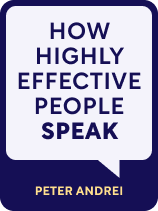

This article is an excerpt from the Shortform book guide to "How Highly Effective People Speak" by Peter Andrei. Shortform has the world's best summaries and analyses of books you should be reading.
Like this article? Sign up for a free trial here.
Do you want to be more persuasive when you speak? How much would it help if you could understand the way people think and feel?
Peter D. Andrei says that attribute substitution is behind a variety of cognitive biases and can be used to influence your audience in subtle yet powerful ways. He explains how you can do this by using emotions as replacement attributes, providing abundant evidence, and presenting social proof.
Read more to learn how to use attribute substitution to influence people.
Attribute Substitution
Attribute substitution is the tendency for people to replace a complex judgment or problem with an easier one. In other words, they substitute an attribute that’s difficult to measure with a simpler one. For example, deciding whom to vote for in a democratic election can be a difficult decision. Many people, instead of reviewing the policies of every person on a ballot, simply vote for the candidates who represent their chosen political party. They substitute a complex judgment with a much easier one.
(Shortform note: Some researchers argue that attribute substitution is a form of unintentional intellectual laziness—we tend to take the easier intellectual route when making decisions. But, one study found that although people intuitively avoid thinking about hard questions and instead think about easy ones, most people are aware of when they do this, suggesting we at least acknowledge that we’re taking mental shortcuts when making many decisions.)
Use Emotions as Replacement Attributes
Andrei contends that appealing to your audience’s emotions—one of the most common and effective persuasive techniques—is a form of attribute substitution. Instead of asking ourselves, “Is this message true?” or “Is it in my best interest to buy this product?” audiences ask, “How does this message or product make me feel?” If it makes them feel good, they’re more likely to approve of a message or purchase a product. If the idea of attracting a romantic partner makes them feel good, they’ll be motivated to buy an electric toothbrush described as a tool to increase their attractiveness.
| Pathos, Storytelling, and Tribalism Appealing to emotions, or pathos, is one of the three Aristotelian modes of persuasion, along with logos (appealing to logic) and ethos (appealing to ethics). In Thank You For Arguing, rhetoric expert Jay Heinrichs writes that because our emotions are stronger than our logical or ethical rationale, using pathos is the most effective way to move an audience into action. Like Andrei, Heinrichs argues that telling a vivid story is a great way to move your audience emotionally. You can appeal to emotions without storytelling, however. For instance, Heinrichs argues that one of the best ways to evoke strong emotions is to appeal to our tribalistic tendencies. People feel loyalty to the group they’re in, whether it be their country, city, school, or any other community they’re a part of. If your communication can make the audience feel like they’re part of a group, or that their group is being negatively affected in some way, they will have strong emotional reactions and be more willing to act on your words. |
Provide Abundant Evidence
Andrei argues that people strongly prefer to see evidence supporting a claim, and you can use this preference to make your argument more convincing—even if the evidence doesn’t actually prove your point. This is because people conflate the existence of evidence with the strength of evidence. Of course, it’s best if your evidence is strong and accurate, but simply providing evidence is often enough to seem convincing. Further, if you can provide abundant evidence, it will make the argument seem even more valid. For example, if you provide four sources rather than one supporting your claim that lower corporate taxes are good for the economy, the audience will be more likely to believe it.
| Statistical vs. Anecdotal Evidence Rhetoricians point out that every argument is based on some kind of evidence, so it’s only natural that people are drawn to arguments that present this evidence explicitly. Though Andrei seems to be pointing to statistical evidence in this section, the use of storytelling to prove a point or back a claim is also a form of evidence, namely anecdotal evidence. So, which form of evidence is more persuasive? A 2020 study tried to answer this question and found that it depends on the emotional weight of the topic or situation. If a claim resonates emotionally (if it involves a serious threat, is health-related, or affects one personally), people are more likely to be persuaded by anecdotal evidence. If the situation doesn’t personally affect someone or trigger strong emotions, they’re more likely to find statistical evidence more persuasive. An example is the public response to the Covid-19 pandemic, a situation that was threatening, health-related, and personally affected virtually everyone on the planet. Though there were mountains of statistical evidence surrounding the pandemic, many people’s opinions on Covid-19 were impacted most by their personal experience. |
Present Social Proof
Another common cognitive bias Andrei points out is our overreliance on the actions and opinions of others to dictate our own. When we rely on social proof, we substitute how others think or behave with how we should think or behave. An ad that claims “nine out of 10 dentists recommend this product” is using social proof, as is a politician who says “80% of Americans support this bill.” Presenting social proof like this will validate your argument in your audience’s eyes.
(Shortform note: In Influence, Robert Cialdini, who coined the term “social proof,” delves further into this cognitive bias. He states that relying on others to dictate thoughts and behaviors generally serves us pretty well—usually, it leads to appropriate decisions and saves us a lot of time and effort. However, this instinct to rely on social proof can lead to harmful consequences, such as when we act on deceptive or manufactured social proof or when the actions of a group go against the standards of the individual. To avoid these negative consequences of social proof, Cialdini recommends taking the time to assess group behavior and to apply individual judgment when necessary.)

———End of Preview———
Like what you just read? Read the rest of the world's best book summary and analysis of Peter Andrei's "How Highly Effective People Speak" at Shortform.
Here's what you'll find in our full How Highly Effective People Speak summary:
- That persuasive speech is a complex craft that can be studied and learned
- How to take advantage of cognitive biases to be more persuasive
- Why trying to manipulate others' thoughts isn't inherently immoral






